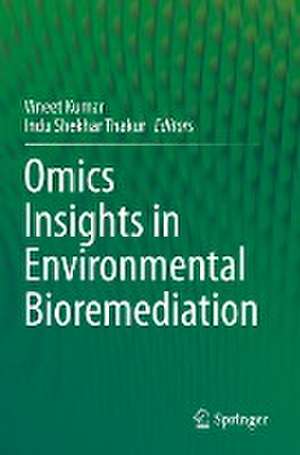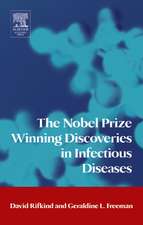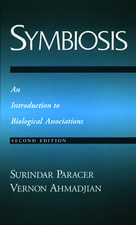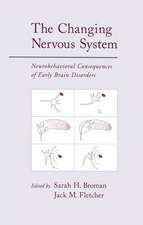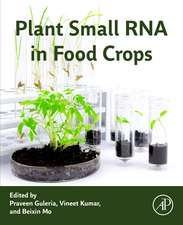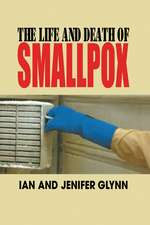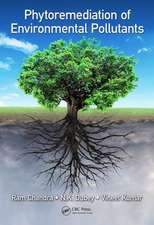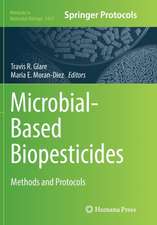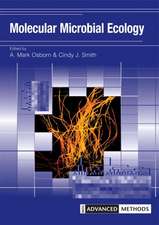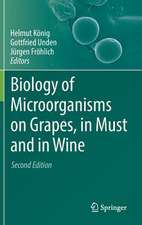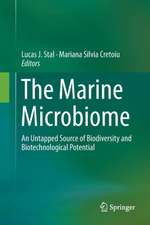Omics Insights in Environmental Bioremediation
Editat de Vineet Kumar, Indu Shekhar Thakuren Limba Engleză Paperback – 28 sep 2023
Environmental pollution emanating from rapid industrialization, population growth, and urbanization has been considered a major problem in recent years that affects biodiversity, ecosystems, and human health by contaminating soil and water. This book brings out a comprehensive collection of information on valuable insights into different cutting-edge omics technologies, such as metagenomics, metatranscriptomics, metaproteomics, and metabolomics, along with advanced next-generation sequencing technologies as well as bioinformatic tools, which led to a better understanding of microbial communities and their adaptability to a wide range of contaminants and underlying their mechanisms in bioremediation and biodegradation of environmental pollutants. In addition, this edited volume provides critical insight into of potent microbial communities endowed with unique functional attributes through their unique metabolism catalyzed by ‘signature’ enzymes and degradation pathways. Step-by-step descriptions are provided of various microbial metabolic pathways of degradation and biotransformation of environmental contaminants by numerous illustrations which make the information easier to understand for the readers. Each chapter is devoted to selected examples of microbial bioremediation supported by tables, and an extensive list of references for readers interested in learning further details about the subject matter. This book is of interest to teachers, researchers to professionals, policymakers, stockholders, practitioners, environmental engineers, soil scientists, and policymakers. In addition, the book serves as additional comprehensive material for undergraduate, graduate, and doctoral students who require a working knowledge and knowhow of ‘Omics’ involved in and required for environmental remediation of legacy and emerging contaminants, will also find this to be a useful read.
| Toate formatele și edițiile | Preț | Express |
|---|---|---|
| Paperback (1) | 595.28 lei 38-44 zile | |
| Springer Nature Singapore – 28 sep 2023 | 595.28 lei 38-44 zile | |
| Hardback (1) | 667.80 lei 3-5 săpt. | |
| Springer Nature Singapore – 27 sep 2022 | 667.80 lei 3-5 săpt. |
Preț: 595.28 lei
Preț vechi: 744.09 lei
-20% Nou
Puncte Express: 893
Preț estimativ în valută:
113.97€ • 116.92$ • 95.96£
113.97€ • 116.92$ • 95.96£
Carte tipărită la comandă
Livrare economică 22-28 februarie
Preluare comenzi: 021 569.72.76
Specificații
ISBN-13: 9789811943225
ISBN-10: 9811943222
Pagini: 702
Ilustrații: XXI, 702 p. 1 illus.
Dimensiuni: 155 x 235 mm
Ediția:1st ed. 2022
Editura: Springer Nature Singapore
Colecția Springer
Locul publicării:Singapore, Singapore
ISBN-10: 9811943222
Pagini: 702
Ilustrații: XXI, 702 p. 1 illus.
Dimensiuni: 155 x 235 mm
Ediția:1st ed. 2022
Editura: Springer Nature Singapore
Colecția Springer
Locul publicării:Singapore, Singapore
Cuprins
Section-I Bioremediation and Biodegradation.- Chapter#1 Bioremediation and Functional Metagenomics: Advances, Challenges, and Opportunities.- Chapter#2 Bioremediation: Gaining Insights Through Metabolomics.- Chapter#3 Metagenomics, Microbial Diversity, and Environmental Clean-up.- Chapter#4 Plant Microbes Association in Remediation of Contaminants for Environmental Sustainability.- Chapter#5 Recent Trends in Bioremediation of Heavy Metals: Challenges and Perspectives.- Chapter#6 Enzyme Technology for Remediation of Contaminants in the Environment.- Section-II Environmental Pollution and Wastewater Treatment.- Chapter#7: Environmental Toxicity, Health Hazards, and Bioremediation Strategies for Removal of Microplastics from Wastewater.- Chapter#8 Microbial Community Composition and Function in Activated Sludge Treatment Systems.- Chapter#9 Decontamination and Management Of Industrial Wastewater Using Microorganisms Under Aerobic Condition.- Chapter#10 Omics of Industrial Wastewater Treatment.- Chapter#11 Microalgae in Wastewater Treatment and Biofuel Production: Recent Advances, Challenges, and Future Prospects.- Chapter#12 Removal of Cobalt, Nickel, Cadmium, And Lead from Wastewater by Phytoremediation (ADilig).- Chapter#13 Microbial Ecology of Wastewater Treatment Processes: Trends, Challenges, and Perspectives.- Chapter#14 Treatment, Recycling and Reuse of Wastewater from Tannery industry: Recent Trends, Challenges, and Opportunities.- Section-III Omics Approaches in Environmental Remediation.- Chapter#15 Metagenomics Tools for Assessment of Microbial Diversity in Bioremediation: A Novel Statistical Approach.- Chapter#16 Understanding in Bioremediation of Metals and Metalloids by Genomic Approaches.- Chapter#17 Bioremediation of Heavy Metals by Metagenomics Approaches.- Chapter#18 Proteomics, Genomics, And Metabolomic Understanding and Designing for Bioremediation of Environmental Contaminants.- Chapter#19 Omics Insight of Cold Environments: Cold Tolerant Microorganisms and Their Bioremediation Potential Use (Edwin).- Chapter#20 Bioremediation Assessment in Industrial Wastewater Treatment: OMICS Approach.- Chapter#21 Microbial biodegradation and metagenomics in remediation environmental Pollutant: Enzyme and Mechanisms.- Chapter#22 OMICS in Biofuel Production: A Sustainable Approach.- Section-IV Recent Trends and Development in Omics Technologies.- Chapter#23 High-throughput Sequencing Technologies in Metagenomics: Advancing Approach for Algal Research.- Chapter#24 Metagenomic Approaches for The Discovery of Pollutants Remediating Enzymes: Recent Trends and Challenges.- Chapter#25 Recent Trends in Metagenomic Approaches in Environmental Cleanup (SP).- Chapter#26 Applications of Metagenomics in microbial diversity and functions analysis; Recent Trends and Advances.- Chapter#27 CRISPR Cas-mediated functional gene editing for improvement in bioremediation: An emerging strategy.- Chapter#28 Metabarcoding approach in identifying potential pollutant degraders.- Chapter#29 Artificial Intelligence in Bioremediation Modelling and Clean-up of Contaminated Sites: Recent Advances, Challenges, and Opportunities.
Notă biografică
Dr. Vineet Kumar is currently working as a Senior Project Associate at CSIR-National Environmental Engineering Research Institute (NEERI), Nagpur, Maharashtra, India. Before his joining, he worked as an Assistant Professor (Ad-hoc) in the Department of Botany at Guru Ghasidas Vishwavidyalaya, Bilaspur, India. He was an Assistant Professor and Academic Coordinator at Vinayak Vidyapeeth, Meerut, Uttar Pradesh. He received his M.Sc. (2010) and M.Phil. degree (2011) in Microbiology from Ch. Charan Singh University, Meerut, India. Subsequently, he earned his Ph.D. (2018) in Environmental Microbiology from Babasaheb Bhimrao Ambedkar (A Central) University, Lucknow, India. Dr. Kumar’s research interest includes Environmental Microbiology and Biotechnology, Bioremediation of hazardous and emerging pollutants, Phytoremediation of heavy metals, Metagenomics of Industrial waste, Wastewater Treatment, Environmental Monitoring, Waste Management; Bioenergy, and Biofuel Production. Presently, his research mainly focuses on the development of integrated and sustainable treatment techniques that can help in minimizing or eliminating hazardous waste in the environment. He has published 28 articles in reputed International Journals, written 4 Proceeding Papers, 40 book chapters, and authored/edited over 14 books on the different aspects of Phytoremediation, Bioremediation, Wastewater Treatment, Omics, Genomics, and Metagenomics, with more than citations 880 and h-index 17. He has presented several papers relevant to his research areas at national and international conferences. He is an active member of numerous scientific societies including the Microbiology Society, UK, and the Indian Science Congress Association, India. He serves as an editorial board member and reviewer for many peer-reviewed journals and has received awards for his work, including the Young Scientist Award, National fellowship, and best poster presentation awards. Dr. Kumar has been serving as a guest editor and reviewer in many prestigious International Journals. He is the founder of the Society for Green Environment, India (website: www.sgeindia.org). He can be reached at drvineet.micro@gmail.com.
Prof. (Dr.) Indu Sekhar Thakur is currently working as a Professor & Director at Amity School of Earth & Environment Science (ASEES) and Head Centre of Excellence in Bio-Energy at Amity University Haryana, Manesar, Gurugram, Haryana, India. He was a Professor in the School of Environmental Sciences (SES) at Jawaharlal Nehru University (JNU), New Delhi, India. He has obtained his M.Sc. (1980) in Life Science, and M.Phil. (1981) in Environmental Science, from JNU, New Delhi, India. At the same institution, he earned his Ph.D. (1986) in Environmental Science. He has more than 35 years of teaching, research, and outreach/extension activities experiences in the field of Environmental Sciences. He and his research group are working on bioremediation, biovalorization, and detoxification of natural and organic compounds, developed bacterial consortium by genetic breeding, characterized genes, and proteins, proteomics, genomics analysis for CO2 sequestration for biomass, enzymes, biodiesel, bio-flocculant, bioplastic, and biomaterials developments. He has published more than 260 research papers, review article and technical reports in peer-reviewed journals of International and National journals of repute with more than citations 7262 and h-index 48. In addition, he has published 4 books and 35 book chapters and completed 22 sponsored research projects funded by various agencies and departments. He has four patents and technologies in his credit. He was Visiting Scientist and Visiting Professor in Germany and Japan, Switzerland, Canada, France etc., and members of several committees visited the USA, Italy, Austria, Netherland, Finland, Sweden etc. He is a member of the editorial board and reviewing committee of several journals and professional societies. He has completed more than 22 research projects as PI and 28 Ph.D., 2 M.Phil., and 14 Post Graduate thesis/dissertations are completed under his supervision. Based upon this outstanding contribution in the areas of environmental microbiology and environmental biotechnology, he has been awarded the Fellow of the National Academy of Agricultural Sciences (FNAAS), Fellow of National Academy of Sciences India (FNAS), Fellow of International Bioprocessing Association (FIBA), Fellow of National Environmental Sciences Academy, and Fellow of Biotech Research Society of India (FBRSI). He is also a member of the American Society of Microbiology, USA, and the Association of Microbiologists of India
Textul de pe ultima copertă
Environmental pollution emanating from rapid industrialization, population growth, and urbanization has been considered a major problem in recent years that affects biodiversity, ecosystems, and human health by contaminating soil and water. This book brings out a comprehensive collection of information on valuable insights into different cutting-edge omics technologies, such as metagenomics, metatranscriptomics, metaproteomics, and metabolomics, along with advanced next-generation sequencing technologies as well as bioinformatic tools, which led to a better understanding of microbial communities and their adaptability to a wide range of contaminants and underlying their mechanisms in bioremediation and biodegradation of environmental pollutants. In addition, this edited volume provides critical insight into of potent microbial communities endowed with unique functional attributes through their unique metabolism catalyzed by ‘signature’ enzymes and degradation pathways. Step-by-step descriptions are provided of various microbial metabolic pathways of degradation and biotransformation of environmental contaminants by numerous illustrations which make the information easier to understand for the readers. Each chapter is devoted to selected examples of microbial bioremediation supported by tables, and an extensive list of references for readers interested in learning further details about the subject matter. This book is of interest to teachers, researchers to professionals, policymakers, stockholders, practitioners, environmental engineers, soil scientists, and policymakers. In addition, the book serves as additional comprehensive material for undergraduate, graduate, and doctoral students who require a working knowledge and knowhow of ‘Omics’ involved in and required for environmental remediation of legacy and emerging contaminants, will also find this to be a useful read.
Caracteristici
Introduces readers to state-of-the-art developments in omics for environmental cleanup Provides case studies, challenges, and future perspectives in each chapter In-depth information on microbial mechanisms with a metabolic pathway for remediation of emerging contaminants
